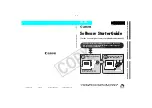
Update packages
Product deployment packages
If not implementing global updating for product updating,
an update client task must be configured and scheduled
for managed systems to retrieve the package.
If not implementing global updating for product
deployment, a deployment task must be configured and
scheduled for managed systems to retrieve the package.
Product deployment and updating process
Follow this high-level process for distributing DAT and engine update packages follows:
1
Check the update package in to the master repository with a pull task or manually.
2
If using global updating, nothing else is necessary, provided global updating has been
configured and enabled.
If not using global updating, use a replication task to copy the contents of the master
repository to the distributed repositories.
3
If not using global updating, create and schedule an update or deployment task for agents
to retrieve and install the update on managed systems.
Deployment tasks
Once you have checked in the product deployment package, use the Product Deployment client
task to install the product on managed systems. The task installs any product that is deployable
through ePolicy Orchestrator and has been checked in to the master repository.
Best practices
You can run the product deployment task for any group or individual system. When deciding
how to stage your product deployment, McAfee recommends considering the size of the package
and the available bandwidth between the master or distributed repositories and the managed
systems. In addition to potentially overwhelming the ePO server or your network, deploying
products to many systems can make troubleshooting problems more complicated.
Consider a phased rollout to install products to groups of systems at a time. If your network
links are fast, try deploying to several hundred clients at a time. If you have slower or less
reliable network connections, try smaller groups. As you deploy to each group, monitor the
deployment, run reports to confirm successful installations, and troubleshoot any problems with
individual systems.
If you are deploying McAfee products or components that are installed on a subset of your
managed systems:
1
Use a tag to identify these systems.
2
Move the tagged systems to a group.
3
Configure a Product Deployment client task for the group.
Update tasks
Once an update package has been checked into the master repository and replicated to the
distributed repositories, the agents on the managed systems still need to know when to go to
the distributed repositories for updates. This is unnecessary if you are using global updating.
You can create and configure update client tasks to control when and how managed systems
receive update packages. If you are not using global updating, creating these tasks are the
only way you can control client updating with ePolicy Orchestrator.
Deploying Software and Updates
Product and update deployment
McAfee ePolicy Orchestrator 4.0.2 Product Guide
134
















































